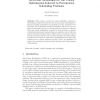Free Online Productivity Tools
i2Speak
i2Symbol
i2OCR
iTex2Img
iWeb2Print
iWeb2Shot
i2Type
iPdf2Split
iPdf2Merge
i2Bopomofo
i2Arabic
i2Style
i2Image
i2PDF
iLatex2Rtf
Sci2ools
IEAAIE
2005
Springer
2005
Springer
Structural Advantages for Ant Colony Optimisation Inherent in Permutation Scheduling Problems
When using a constructive search algorithm, solutions to scheduling problems such as the job shop and open shop scheduling problems are typically represented as permutations of the operations to be scheduled. The combination of this representation and the use of a constructive algorithm introduces a bias typically favouring good solutions. When ant colony optimisation is applied to these problems, a number of alternative pheromone representations are available, each of which interacts with this underlying bias in different ways. This paper explores both the structural aspects of the problem that introduce this underlying bias and the ways two pheromone representations may either lead towards poorer or better solutions over time. Thus it is a synthesis of a number of recent studies in this area that deal with each of these aspects independently.
| Added | 27 Jun 2010 |
| Updated | 27 Jun 2010 |
| Type | Conference |
| Year | 2005 |
| Where | IEAAIE |
| Authors | James Montgomery, Marcus Randall, Tim Hendtlass |
Comments (0)

